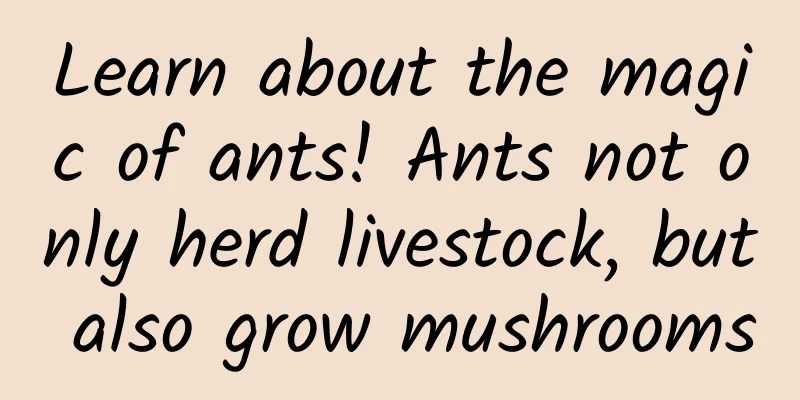Learn about the magic of ants! Ants not only herd livestock, but also grow mushrooms

|
Produced by: Science Popularization China Author: Qin Yalong (Institute of Botany, Chinese Academy of Sciences, Jiangsu Province, Nanjing Zhongshan Botanical Garden) Producer: China Science Expo Editor's note: In order to decode the latest mysteries of life science, the China Science Popularization Frontier Science Project has launched a series of articles called "New Knowledge of Life" to interpret life phenomena and reveal biological mysteries from a unique perspective. Let us delve into the world of life and explore infinite possibilities. Ants first appeared on Earth 100 million years ago in the Cretaceous period, when dinosaurs still ruled the vast continents of the Earth. However, after the Cretaceous-Tertiary extinction event, most species, including dinosaurs, became extinct, but the ancestors of ants survived tenaciously. After evolution to date, the wide variety of ants have become the most perfectly evolved creatures on Earth. It can be said that wherever there are humans, there are ants. The ant family is unmatched by other creatures in terms of its wide distribution, large number, many species, and strong abilities. During the long evolution process, ants have established close mutually beneficial symbiotic relationships with various plants, insects or fungi. During the interaction, ants can protect plants or help them pollinate and spread seeds, and plants give back to ants with shelter and food. Ants can also obtain the food they need in the interaction with insects and fungi, which is amazing. Ants can "herd" After a long period of evolution, ants not only get food from nature, but also learn the skill of "grazing" in the process of getting along with nature. Like shepherds, they get a steady supply of food by grazing on pastures. The most famous is ants "grazing" aphids. They will move aphids to the tender tips of plants, and aphids will begin to suck the juice of plants crazily. At this time, the ants will use their antennae to constantly stimulate the abdomen of the aphids, so that the aphids continue to secrete "honeydew" for the ant colony to eat. Ants herding aphids on Hypericum longituba (Photo credit: Photo taken by the author) In addition to aphids, ants also "graze" the larvae of scale insects, treehoppers, psyllids, leafhoppers, Lepidoptera and other insects to obtain the secretions of insect young. Of course, ants are both shepherds and guardians. While obtaining food, they also provide these insects with sufficient protection so that they can "produce milk" with peace of mind. In this way, ants and these insects achieve a mutually beneficial symbiosis, which is scientifically called "aphid-ant symbiosis." Ants herding aphids on wisteria (Video source: taken by the author) As "shepherds", ants need to get as much food as possible from "grazing" insects. Take aphids as an example. In order to collect "honeydew" every year, ants will move aphid eggs to ant nests for storage in winter. When the eggs hatch, they will be moved to the roots, tender tips, flower buds and other parts of the plants for "grazing". When the same "pasture" is overloaded with grazing insects, ants will move the extra insects to open up new "pastures". During the "grazing" process, ants sometimes build fences to "enclose" insects to prevent them from running around. What's more, ants will damage or bite off the wings of "grazing" aphids, or release special chemical pheromones to inhibit the development of aphid wings and control the crawling speed of aphids. Aphids that have been busy eating since childhood cannot fly away, and even if they want to crawl, they can't crawl fast. What's more, the latest research shows that ants also release two tracking pheromones to inhibit the spread of wingless aphids and stimulate their reproduction. While continuously expanding the "grazing" population, the aphids are completely forced to give up the idea of escaping and "produce honey" with peace of mind, thus ensuring that the "grazing" aphids are always under control. Can you say that ants like this are not evolved perfectly? They have so many tricks just for stuttering, and these are just what we know. They should have many survival skills that we have not yet discovered. Ants can also grow mushrooms The history of human civilization is accompanied by the history of domestication of plants and animals. When the environment changed, ants also learned to obtain food by growing and domesticating fungi in order to survive and reproduce. It should be noted that the various mushrooms we eat are also fungi, so it can be understood that ants have also mastered the skills of domesticating and growing mushrooms. As early as about 60 million years ago, leaf-cutter ants living in the tropical rainforests of South America learned to grow fungi to obtain food. They are called "fungus-growing ants" and the fungi they grow are called "symbiotic fungi". At present, there are more than 200 species of fungus-growing ants found in the world. The fungi they grow are an important source of nutrition for adult leaf-cutter ants and the only food source for young ants. A unique symbiotic relationship has been formed between fungi and leaf-cutter ants. The study found that according to the level of fungal cultivation of leaf-cutter ants, they can be divided into high-level leaf-cutter ants and low-level leaf-cutter ants. In order to cope with the changes in habitat drought, high-level leaf-cutter ants changed from cultivating wild fungi to domesticating specific fungi. Later, the domesticated fungi lost the ability to survive outside the moist ant nests, and even lost the ability to hybridize and reproduce with wild fungi, becoming an exclusive fungal group for leaf-cutter ants. Leaf-cutter ants carrying leaves (Photo source: veer photo gallery) Like the "grazing" ants, the leaf-cutter ants that grow fungi also have many skills. They are not only "master builders" who can build nests several meters deep for the ant colony to survive, reproduce and grow fungi, but also create extra-large entrances and passages to facilitate the transportation of leaves and ventilation of the nests. At the same time, they also build complex waste disposal systems in the nests to prevent the nests from being contaminated by other pathogens. Leafcutter ants are also highly skilled "farmers". Larger worker ants will work in teams to cut leaves from plants and carry them back to the nest, while smaller worker ants will further cut and grind the leaves into pulp, smear it on the fungal bed used to cultivate fungi, and inoculate the fungal bed with fungal hyphae in the ant nest. When leaf-cutter ants are cutting leaves from plants, the vanguards will release tracking pheromones along the way, thereby guiding their later companions to follow the set navigation route to the destination, cut leaves and carry them back to the nest. When growing fungi, leafcutter ants not only use their excrement to fertilize the fungus bed, but also keep the ant nest clean and the fungus bed pure at all times, so that the fungus bed can grow healthily and avoid pollution. Some leafcutter ants have a type of Streptomyces that can produce antibiotics hidden in the tiny glandular crypts on their mouths and forelimbs. The antibiotics secreted by Streptomyces can effectively prevent the cultivated fungi from being destroyed by other parasitic fungi or pathogens. Of course, leafcutter ants also need to start a family. When the ant colony develops to a certain stage, winged leafcutter ants will be bred. When they mature, they will choose to fly away from the ant nest. These flying leafcutter ants are divided into male and female. There is also a prospective queen ant among the female leafcutter ants. It will fly away with a small ball of ant nest fungus stored in the cheek pouch (a special bag-like structure for storing mycelium). After the "nuptial flight", the prospective queen ant obtains the love seeds of countless male ants, and establishes a new ant nest with the fungus inherited from the old nest, starting the next round of population reproduction and fungus cultivation. Ant Nest (Photo source: veer photo gallery) If you want to eat chicken mushrooms, you have to rely on termites If leaf-cutter ants grow fungi (mushrooms) for their own enjoyment, then termites growing fungi (Aconitum caryophyllus) can be said to be "helping others achieve their goals." Alternaria albuminata is a fungus of the genus Myrmecophaga in the family Synechophylla. It is a general term for a type of large fungus that can coexist with termites. It is distributed in many provinces of my country. It is known as a treasure of wild edible fungi because of its thick and fine flesh, sweet taste and rich nutrition. Since ancient times, Alternaria has been known as chicken mushroom, chicken silk mushroom, termite mushroom, termite umbrella, etc. The name indicates that Alternaria tastes as delicious as chicken, and also points out the close relationship between Alternaria and termites. The story of termites and Alternaria also happened in ant nests. When termites build nests, worker ants use semi-digested food residues to build nests, and in this process, Alternaria spores (seeds) are sown. In order for the spores to thrive, termites will build the most suitable growth environment for Alternaria in the ant nest and ensure a continuous supply of nutrients. Under the careful care of termites, the spores will gradually grow into micrometer-sized white spherical mycelium, and then develop into the stipe and cap of the chicken mushroom (collectively called the fruiting body). Only after drilling out of the ground, it is the chicken mushroom we eat, like a small umbrella. If there is no human interference, when these chicken mushrooms mature, they will spread spores. Agaricus fasciata growing on a termite nest (termites are circled) (Photo credit: Photo taken by the author) Young ants growing in the nest feed on the small white ball-shaped mycelium of Altissima from childhood, from which they obtain the necessary nutrients and disease-resistant substances. Therefore, while obtaining food, young ants carry undigested strains of Altissima in their bodies. When young ants mature and migrate to other places to build nests, the strains in their intestines will be brought to the new ant nest. Of course, there is another way for Alternaria to spread. When the worker ants of a newly built ant nest are out and about, they sometimes bring back Alternaria mycelium or spores from other mature termite symbiotic systems to the ant nest, and then grow their own food and delicious Alternaria. The growth of Alternaria needs to coexist with termites. There must be termite nests under the land where Alternaria grows. For those of us who like to taste the delicious Alternaria, if we are not 100% sure when collecting it in the wild, it is recommended not to taste it rashly. After all, among the many fungi with white umbrellas and white stems, there are also many that may "lie down" after eating. If you must collect it, it is best not to dig too deep, so as not to destroy the ant nests that the termites have worked hard to build, and you can also look forward to another bumper harvest of Alternaria. Alstroemeria (Photo credit: Photo taken by the author) For a long time, wild Alstroemeria albuminata has been far from satisfying people's taste buds, and people hope to achieve large-scale production of Alstroemeria albuminata through artificial cultivation technology. In recent years, many scientific research institutions have been conducting relevant research. The Xishuangbanna Tropical Botanical Garden of the Chinese Academy of Sciences simulated the growth environment of wild Alternaria albuminosa in the wild and sowed the artificially cultivated termite-Alternaria albuminosa symbiotic nests in the wild planting test area. It is expected that 5,000 to 6,000 Alternaria albuminosa flowers will be harvested throughout the year in 2024. The Kunming Institute of Forestry and Grassland Sciences also grew the first Alternaria albuminosa flower in the laboratory-cultivated termite-Alternaria albuminosa symbiotic nest in May 2024. I believe that with the joint efforts of scientists, we can achieve Alternaria albuminosa freedom in the near future. References: 1.Branstetter, Michael G., et al. Dry habitats were crucibles of domestication in the evolution of agriculture in ants[J]. Proceedings of the Royal Society B Biological Sciences, 2017, 284(1852):20170095. 2.Currie, Cr, et al. Coevolved Crypts and Exocrine Glands Support Mutualistic Bacteria in Fungus-Growing Ants[J]. Science, 311.5757(2006): 81-83. 3.Oliver TH, Mashanova A, Leather SR, et al. Ant semiochemicals limit apterous aphid dispersal[J]. Proceedings of the Royal Society B: Biological Sciences, 2007. 4.Padje AV' , Peppel LJJVD , Aanen DK . Evolution: Ant trail pheromones promote ant-aphid mutualisms[J]. Current Biology, 2021, 31(21): R1437-R1439. 5.Xu T , Xu M , Lu Y ,et al.A trail pheromone mediates the mutualism between ants and aphids[J]. Current biology: CB, 2021, 31(21):4738-4747.e4. |
>>: How was bronze ware “forged”?
Recommend
Instant messaging apps are growing faster than social networking sites
Instant messaging apps and social networks, which...
How will China's robotics industry take the lead in the battle for discourse power under the market size of 600 billion yuan?
Artificial intelligence and the robotics industry ...
Let’s talk about the operation and promotion of mobile games!
What to do when you are bored? Let’s play a game ...
Momo, which has 200 million users, not only offers hookups, but also offers information flow ads
When the word "Momo" comes into view, a...
The trillion-dollar new business model of smart cars is driven by billions of sensors that you don’t know about
If electrification is the first half of the autom...
Hu Xinshu vs. Papi Jiang, self-media selling itself to capital: one thought to heaven and one thought to hell?
If the first half of 2016 belonged to Papi Jiang,...
How to come up with marketing ideas that go viral? (superior)
In the 5th century BC, there was a most respected...
Can you subdue a crocodile by pinching its mouth with one hand? Why don't you go to heaven!
What? Last time there was a news report about a c...
Having trouble with mobile development? Find MDSA! —China’s first Mobile Developer Service Alliance (MDSA) was established
In the past two years, with the fragmentation of ...
Why does dandruff increase in winter?
Reviewer: Zhang Yuhong, Chief Physician, Departme...
Night Grass and the Thousand-Li Horse Edmund "Short Video Copywriting Course that Can Be Popular Just by Talking" Episode 19
Training course video lecture content introductio...
Analysis of Alibaba Unidesk’s Marketing Model
Introduction Only with ideas can you break the ro...
"Building an operational anchor from 0-1" anchor foundation, mentality shaping, ability training to live broadcast rhythm, speech skills
Course Contents: Section 1: Traffic push mechanis...
Android 12 will make it easier to update the operating system: you can update it through the app store
Google has launched Project Mainline to improve t...
Can this "hyped-up" probiotic really treat allergic rhinitis? Listen to what the doctor says →
gossip "There are probiotics specifically fo...









